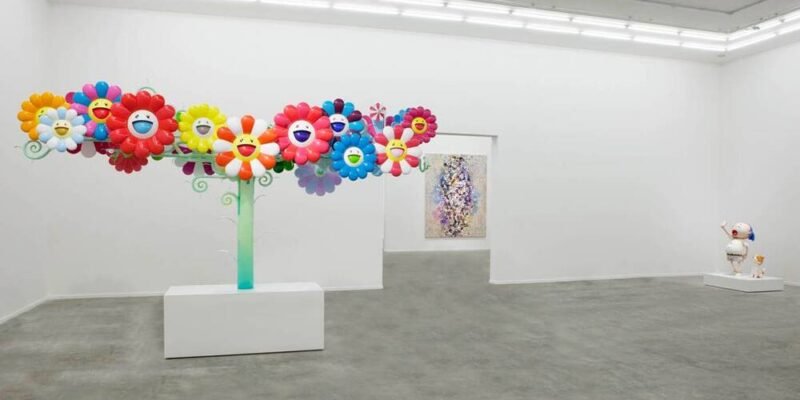The Vivid Flowers by Takashi Murakami
The vivid flowers by Takashi Murakami have evolved from their humorous looks to become important emblems in modern art. These happy themes captivate a worldwide audience with emotional relevance by fusing traditional Japanese appearance with contemporary sensibilities. Murakami’s work is a prime example of how artists push limits, question conventions, and engage audiences with novel shapes and subjects in the context of contemporary sculpture.
Murakami’s Flowers and Globalization
Many of Murakami’s flowers were created in the late 1990s, a period of fast globalization and consumer culture. Murakami’s art resonates with the experiences and ambitions of the general population. It represents the flattened hierarchies between high and low culture, influenced by his Superflat movement.
Evolution of Modern Sculpture
Similarly, modern sculpture has developed to accept a wide range of inspirations. It frequently uses unconventional materials and methods that go against traditional expectations of art. Today’s artists use sculpture to address social, political, and emotional issues, drawing inspiration from their cultural surroundings. The merging of these cultural narratives in Murakami’s flower motifs and sculptures emphasizes the interdependence of contemporary artistic practices.
Japanese Folklore and Popular Culture
Japanese folklore, popular culture, and individual experiences are only a few of the many sources of inspiration for Takashi Murakami flowers. They respond to social demands by becoming playful, which gives observers a sense of connection and joy in the face of complexity.
Emotional Landscapes and Cultural Backgrounds
Similarly, contemporary sculpture artists often draw inspiration from their emotional landscapes and cultural backgrounds. They use unusual materials to elicit discussion and reflection on identity and societal challenges to produce significant pieces. Murakami’s work can be viewed as a component of this more substantial movement as an example of how cultural and personal narratives influence modern artistic expressions.
Digital Integration of Murakami’s Flowers
Murakami’s flowers have evolved to fit into the digital age as technology advances. Limited editions of Murakami’s floral designs outside conventional forms have enabled the artist to reach new audiences through the rise of NFTs (Non-Fungible Tokens). This change reflects the increasing cultural acceptance of digital art and encourages new discussions about ownership and creative worth.
Technological Integration in Contemporary Art
Similar to Murakami’s investigation of digital platforms, this technological integration shows how contemporary artists can experiment and interact with their audiences using novel methods.
Murakami’s Impact on Contemporary Art Appreciation
Murakami’s flowers have encouraged a broader appreciation for various artistic forms, profoundly impacting contemporary art. Their approachability has increased the relatability of modern art, allowing spectators to establish a personal connection with the artwork. Other artists have been motivated by this accessibility to use sculpture to examine identity, culture, and emotion.
Influence on New Generations of Sculptors
Furthermore, a new generation of sculptors has been inspired to explore similar paths by Murakami’s ability to negotiate the nexus between great art and commercialism successfully. Today’s artists frequently combine high art and popular culture to produce works that defy convention and speak to a broader audience.
Abstract Themes in Contemporary Sculpture
Like Murakami’s flowers, abstract ideas like human emotion, societal dynamics, and nature are frequently explored in contemporary sculpture. The variety of themes reflects the artists’ aim to arouse viewers’ emotions and inspire thought. Like Murakami’s emphasis on universal human experiences, sculptors investigate topics like identity, cultural history, and environmental sustainability.
Reflection of Human Experience in Art
This thematic richness emphasizes how Murakami’s floral designs and contemporary sculptures act as mirrors reflecting the complexity of the human experience, promoting discussion on the place of art in society.
Emotional Depth and Cultural Relevance
The emotional depth and cultural relevance of Takashi Murakami’s flowers have made them potent emblems of contemporary art that profoundly impact viewers worldwide. Murakami’s sculptures are an outstanding representation of how artists can exceed limits, work with various subjects, and produce approachable art that encourages interaction in contemporary sculpture.
Influence on Artists and Spectators
Murakami’s flowers continue to profoundly influence contemporary sculpture, inspiring both artists and spectators to appreciate the beauty of imagination and the strength of shared experiences in a world growing more complicated by the day. Murakami’s flower motifs and contemporary sculptures influence the artistic environment through their distinct narratives, promoting a greater comprehension of our universality.
Distinctive Style of Murakami’s Sculptures
Takashi Murakami’s sculptures frequently include vivid colors, whimsical shapes, and exaggerated figures. These pieces’ colorful style and accessibility appeal to a worldwide audience. Still, they also contain deep-seated messages about globalization, consumerism, and cultural identity. His large-scale sculptures, such as Flower Matango (2001-2006) and Oval Buddha (2007-2010), demonstrate his ability to create intricate, monumental forms that draw inspiration from traditional Japanese art and popular iconography. As such, his work is relevant to discussions about the intersection of commodification and culture in contemporary sculpture.
Addressing the Legacy of Postmodern Art
Murakami’s sculptures also address the legacy of postmodern art, which blurs the distinction between art and commerce—a notion previously examined by artists such as Andy Warhol. His Mr. DOB figure, for instance, is a visual mashup of Western and Japanese comic characteristics that appears in many sculptures and critiques the ubiquitous nature of global corporations and consumer society.
Commercial Collaborations and Art Market Concerns
His Louis Vuitton series shows that he regularly collaborates with commercial companies on his sculptures. His sculptures’ collector quality and these partnerships raise concerns about authenticity and value in the modern art market by reflecting on the monetization of art in general. By doing this, Murakami links his sculpture to broader discussions in modern sculpture concerning production, materiality, and the artist’s position.
Combination of Traditional and Digital Processes
Furthermore, Murakami’s method of sculpting mirrors more general changes in the medium, especially the combination of conventional and digital processes. His vast, technically intricate works frequently conflate painting and sculpture. They are produced using cutting-edge techniques, including digital modeling and 3D printing. This aligns him with a new wave of sculptors pushing the limits of technique and manufacturing.
Multidisciplinary Character of Contemporary Art
He is firmly established in the current sculptural discourse, where artists explore with form, materials, and production techniques, reflecting the increasingly multidisciplinary character of contemporary art practice, thanks to his work’s scale and technical innovation. Despite having its roots in a very Japanese visual heritage, Murakami’s sculptures speak to universal issues. They are essential to discussing how sculpture will develop in the global art scene.
Do Read: 7 Reasons Why Business Travel Remains Crucial in 2024













